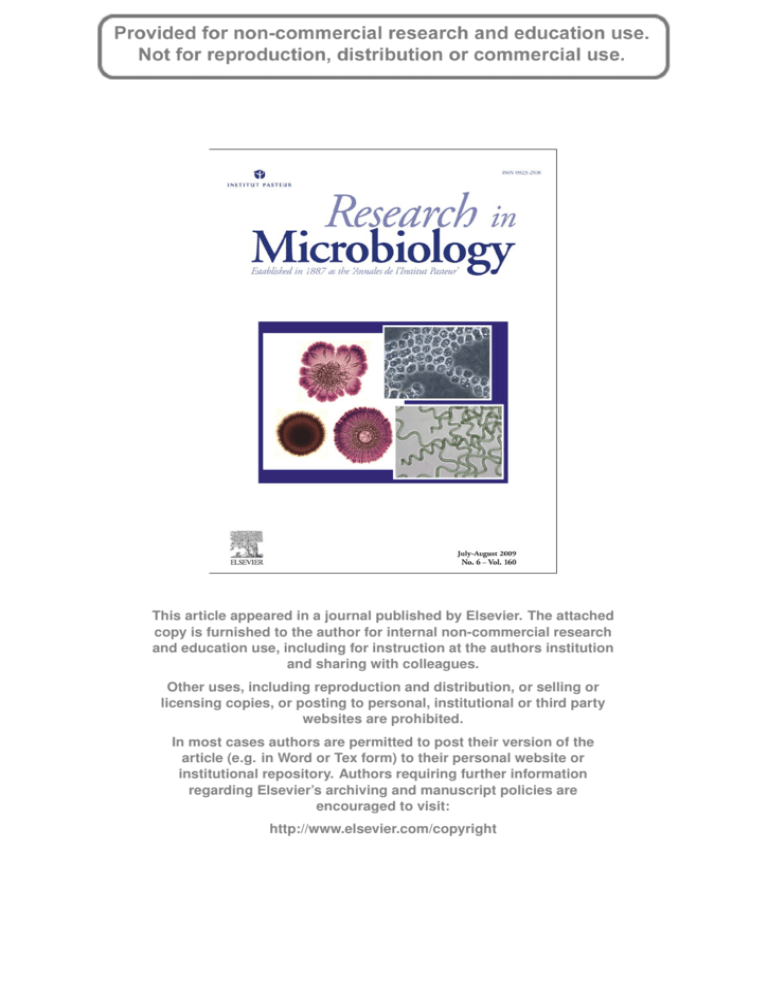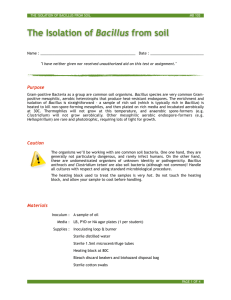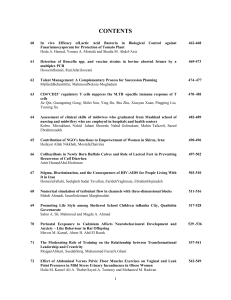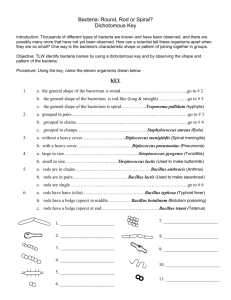
This article appeared in a journal published by Elsevier. The attached
copy is furnished to the author for internal non-commercial research
and education use, including for instruction at the authors institution
and sharing with colleagues.
Other uses, including reproduction and distribution, or selling or
licensing copies, or posting to personal, institutional or third party
websites are prohibited.
In most cases authors are permitted to post their version of the
article (e.g. in Word or Tex form) to their personal website or
institutional repository. Authors requiring further information
regarding Elsevier’s archiving and manuscript policies are
encouraged to visit:
http://www.elsevier.com/copyright
Author's personal copy
Research in Microbiology 160 (2009) 375e379
www.elsevier.com/locate/resmic
Defining the natural habitat of Bacillus spore-formers
Huynh A. Hong a, Ellen To a, Saad Fakhry b, Loredana Baccigalupi b,
Ezio Ricca b, Simon M. Cutting a,*
a
School of Biological Sciences, Royal Holloway, University of London, Egham, Surrey TW20 0EX, UK
b
Department of Structural and Functional Biology, Federico II University, Naples, Italy
Received 11 May 2009; accepted 24 June 2009
Available online 7 July 2009
Abstract
Our understanding of the genetics and physiology of the spore-forming genus Bacillus is remarkable. On the other hand, though, where these
Gram-positive bacteria live and grow is far from clear. The soil, once considered their habitat, may simply serve as a reservoir. A growing
number of studies show that Bacillus spores can be found in the intestinal tracts of animals, raising the question of whether this could be where
they live and grow. In this study, we have conducted the first evaluation of Bacillus spore formers in soil and in human faeces. Our aim is simply
to determine the abundance of aerobic spore-formers. Our results show that soil carries approximately w106 spores/g while human faeces an
average of up to 104 spores/g. The numbers of spores found in faeces, we reason, is too high to be accounted for principally by ingestion of food
contaminated with spores from soil. This provides further evidence that Bacillus spore formers may have adapted to survival within the intestinal
tract of insects and other animals that ingest them; if so they may well be hitherto undiscovered gut commensals.
Ó 2009 Elsevier Masson SAS. All rights reserved.
Keywords: Bacillus species; Endospores; Spore-formers; Soil microorganisms; Gut commensals
1. Introduction
Bacterial endospore-formers typically fall under two major
groupings of Gram-positives, the Bacilli and Clostridia. Many
other spore-forming genera exist, including Gram-negatives,
but for the most part, these remain poorly understood [12]. In
the case of Bacillus, most members have long been considered
soil organisms [25]. This assumption is based upon culturedependant methods of isolation that enrich for the presence of
endospores, implying abundance [11]. In recent years, it has
become apparent that this may be an oversimplification and
Bacillus endospores have been found in diverse environments
including rocks, dust, aquatic environments and the gut of
various insects and animals [25]. Endospores are uniquely
robust life forms enabling them to be dispersed easily and, as
* Corresponding author. Tel.: þ44 (0)1784 443760; fax: þ44 (0)1784
414224.
E-mail address: s.cutting@rhul.ac.uk (S.M. Cutting).
0923-2508/$ - see front matter Ó 2009 Elsevier Masson SAS. All rights reserved.
doi:10.1016/j.resmic.2009.06.006
a result, found everywhere [24,25]. From a purely academic
viewpoint, it is ironic that, for an organism that is genetically
so well defined, on a par with Escherichia coli, its true habitat
and life cycle is so poorly understood. One question that has
been raised is whether there is a symbiotic relationship
between Bacillus spp. and insects and animals [25]. For
insects, in particular, there is stronger evidence for commensalism where the host benefits. For example, cockroaches fed
with Bacillus cereus exhibited direct and positive weight gains
[10]. An obligate, endosymbiotic, relationship with the Grampositive endospore former, Metabacterium polyspora has been
shown in the gut of the guinea pig [1] demonstrating that for
some endospore formers, at least, there must also be direct
benefits to the bacterium. Bacillus spp. are being used as
probiotics for livestock, aquaculture as well as functional
foods for human consumption [16]. For animal use, there are
direct and substantiated benefits to animal health including
weight gains and prevention of disease. In rabbits for example,
Bacillus subtilis has been shown to have a direct effect on the
development of the gut-associated lymphoid tissue (GALT)
Author's personal copy
376
H.A. Hong et al. / Research in Microbiology 160 (2009) 375e379
[28]. Interestingly, these studies showed that sporulation, per
se, was required for this phenomenon. This has been supported
by murine studies that have shown, in vivo, that ingested
endospores are able to germinate, proliferate and then resporulate in the small intestine [33]. Bacillus endospores then
must have a much more intimate relationship with insects and
animals than might be expected if their primary habitat were
only the soil. We have raised the possibility that Bacillus
species are able to exploit the intestinal tract as a habitat [33].
This has been supported by a number of studies that have
recovered Bacillus spp. from the small intestine and from
faecal samples [9,17]. In this work, we have examined the
abundance of aerobic endospore formers in samples of human
faeces as well as soil samples. Our results suggest that the
human gastrointestinal (GI) tract is populated with Bacillus
spore-forming species but these counts are at least 100-fold
lower than the counts found in soil.
2. Materials and methods
2.1. Collection of faecal samples
Freshly voided faeces was collected from healthy volunteers and weighed by difference. Volunteers had not taken
antibiotics or probiotics within the preceding 12 months and
were recruited from the vicinity of either London or Naples.
Faeces was stored at 4 C and processed within 2e3 h of
collection.
2.2. Soil samples
Approximately 10e20 g of soil (weighed by difference)
was collected from selected locations in the London region. In
each case, soil at a depth of 5e10 cm below the surface was
collected. Samples were stored at 4 C prior to analysis.
2.3. Determination of counts of spore-forming bacteria
Bacterial endospore formers were counted using two
methods, heat or ethanol treatment. Faecal or soil samples
(approx. 1e10 g) were suspended in the minimal volume of
sterile phosphate-buffered saline (PBS) that allowed adequate
suspension of solid matter by vigorous vortexing. In some
cases, sterile glass beads (2 mm) were used to aid homogenisation of solid matter. For heat treatment, homogenised
samples were heated in an oven at 65 C for 45 min. For
ethanol treatment 1 volume of homogenised sample was
mixed with an equal volume of absolute alcohol and incubated
for 1 h at room temperature (RT). After both heat or ethanol
treatment, samples were immediately serially diluted and
plated out on three solid media, Difco-Sporulation medium
(DSM; [26]), MRS agar (Oxoid) and MacConkey’s agar
(Oxoid). Plates were incubated for 2e3 days at 30 C and in
the case of MRS agar plates were incubated anaerobically
using a Don Whitley anaerobic cabinet.
2.4. Other methods
Catalase activity was confirmed by emulsification of single
colonies in a 3% solution of hydrogen peroxide (Sigma). The
one-way ANOVA test was used to compare the significance
between groups.
3. Results and discussion
Faecal and soil samples were examined for quantification
of bacterial endospores using a culture-dependent approach.
Spore counts from faecal samples were taken from volunteers
in an Italian study (Fig. 1A and Supplementary Table 1) and
20 from the UK (Fig. 1B and Supp. Table 2). As controls, the
number of enterobacteria and lactobacilli were enumerated
using growth on MacConkey’s and MRS agar [14] respectively. Faecal counts for the enterobacteria and lactobacilli
ranged between 106e107 for the former and 107e109 for the
latter. Counts of lactobacilli using MRS medium were in
agreement with other work [13] as were counts for the
enterobacteria, demonstrating that our methodology was
sound. In addition, 50 soil samples were examined (Fig. 2
and Supp. Table 3). Our analysis was designed to identify
aerobic endospore formers and therefore excluded species of
the strict anaerobes, i.e., Clostridia. Colonies were randomly
tested for their catalase reaction and always tested positive,
further excluding the possibility of Clostridia. The Gram
stain was also performed on some isolates confirming in all
cases the presence of Gram-positive rods. Thus, the vast
majority of recovered strains were most probably species of
Bacillus.
3.1. Spore formers are recovered from human
faecal samples
Heat treatment (65 C, 45 min.) should kill all vegetative
cells, but it is worth mentioning that endospores of some
species are resistant to only 60 C. For example, endospores of
some strains of B. cereus showed a reduction in viability after
heat treatment at 65 C [15]. We used 65 C since, at 60 C,
residual fungal contamination was sometimes observed, and
therefore our counts are probably a slight underestimate of the
true numbers of aerobic endospore formers. While a surprisingly high number of bacterial species produce endospores
[12], the most ubiquitous is Bacillus and it is likely that these
represent the majority of the recovered counts. Our counts
averaged at about 104 CFU/g and were therefore similar to
those from a study of heat-treated human samples in Vietnam
[33], although counts for adults were somewhat higher in the
Vietnamese study. Using ethanol produced somewhat different
results with lower endospore counts (w103) compared to heat
treatment. There are a number of explanations: first, the study
was performed in two different laboratories and two different
countries and we cannot rule out the possibility of a slight
variation in the methodology or reagents. A second possibility
is that this reveals a real difference perhaps caused, for
example, by diet. We believe, though, that the lower counts
Author's personal copy
H.A. Hong et al. / Research in Microbiology 160 (2009) 375e379
A
B
(Italy)
1010
male
male
female
108
c. f. u. /g sample
c. f. u. /g sample
108
106
104
102
100
(UK)
1010
female
377
106
104
102
ethanolR
spores
enterobacteria
lactobacili
100
heatR
spores
enterobacteria
lactobacili
Fig. 1. Aerobic spore formers isolated from human faeces. Panel A shows counts of spores (CFU/g) obtained by ethanol treatment of freshly voided samples. Panel
B shows counts obtained by heat-treatment. Plates were grown aerobically. Levels of enterobacteria and lactobacilli were determined by plating untreated samples
on MacConkey’s and MRS agar respectively. Raw data is given in Supp. Tables 1 and 2.
reflect the choice of ethanol for detection of endospore counts.
The premise for using ethanol as a selective treatment was
a previous study suggesting better enumeration of endospore
counts compared to heat treatment [19]. In this work though,
endospores evaluated were, at most, 5 days old. It is well
understood that ‘aged’ spores are less capable of germinating
synchronously and they must be heat-activated prior to culture
on rich media [22]. If endospores found in the faeces (and also
the soil samples; see below) are in this state of heightened
dormancy, then this might explain the slight difference in
endospore counts between the two studies. Although some
differences existed between sexes, endospore counts were
8
10
6
c. f. u. /g sample
10
4
10
2
10
0
10
heatR
ethanolR
Fig. 2. Aerobic spore formers isolated from soil samples. Fifty soil samples
were examined for the presence of aerobic spore formers (CFU/g) using
ethanol or heat treatment. Raw data is given in Supp. Table 3.
always higher in females, although the differences were not
significant (P > 0.05).
3.2. Aerobic spores present in soil
Counts of aerobic endospore formers were, on average, 10to 100-fold higher than faecal counts with an average of
105 CFU/g. As with faeces, heat-treatment generated somewhat higher numbers. Colonies identified were, in general,
more pleiomorphic in appearance with rhizoid-type colonies,
pinpoint as well as crenated forms. We also found that up to
15% of colonies identified from soil were pigmented.
Pigmentation in endospores provides them with an extra level
of protection against UV irradiation and an attribute of highvalue if they are to remain dormant in the soil for long periods
of time [21]. A variety of pigments have been found in
Bacillus species including reds (Bacillus atrophaeus [21] and
Bacillus megaterium [20]), dark-grey (B. atrophaeus [21]),
yellow and orange (Bacillus indicus [32] and Bacillus cibi
[35]). In many cases, the pigments are carotenoids that
provide natural antioxidative properties [6,21]. Intriguingly,
we found that at low dilutions, pigmentation was difficult to
detect even when colonies were well isolated. On the other
hand, at higher dilutions, for example, with 20e100 colonies
on a plate, as many as 15% of colonies derived from heat-or
ethanol-treated soil were pigmented (data not shown). It is
possible that in a nutrient-rich environment (i.e., at high
dilution), pigmentation is enhanced implying some form of
catabolite repression. In any event, the main discovery, we
surmise, is that a large number of endospore-formers are able
to form pigments and the use of classical culture-dependant
methods of identifying soil endospore formers may have
Author's personal copy
378
H.A. Hong et al. / Research in Microbiology 160 (2009) 375e379
failed to identify these. We believe then that the soil potentially offers a large reservoir of yet undiscovered pigmented
endospore formers.
3.3. Endospores found in food products
A potential source of the spores found in the human GI tract
is through food. Endospores are commonly found in food
products where their presence can be linked to the soil. For
example, populations of endospores (typically, B. cereus,
B. licheniformis and B. subtilis) in pasteurised milk can reach
103 CFU/ml and they have been shown to contaminate milk
from silage, bedding as well as faeces [34]. During prolonged
storage, germination, outgrowth and proliferation of endospores can substantially increase counts of live bacteria to as
high as 106 CFU/ml [27]. Other food sources that carry
Bacillus endospores at levels reaching 102 CFU/g are rice,
grain and vegetables. In all cases, the origin of these endospores can be attributed to soil but as with milk storage, if
endospores can germinate and proliferate the numbers of
bacteria can increase substantially [2,29].
a number of logistic and technical reasons why this approach
is problematic. Still, those studies that examined soil using
fluorescent antibodies failed to convincingly prove the existence of vegetative B. subtilis in the soil other than an association with decaying plant matter [30]. Other studies have
demonstrated that sporulation of B. subtilis cannot occur at
temperatures below 15 C [3]. For an organism purported to
live in the soil, this result is difficult to explain, but rather
supports the hypothesis that endospores, while found in the
soil, have adapted to survive within the GI-tract of animals that
ingest them. How these Gram-positive endospore formers have
adapted to life within a host remains to be seen, yet B. subtilis
is now being subject to microarray-based comparative genomics, revealing a remarkable diversity within this single
species [8].
Acknowledgements
This work was supported by a grant (KBBE-2007-207948)
from the EU 7th Framework to SMC and ER.
3.4. The true habitat of Bacillus species
Appendix. Supplementary information
If we assume that soil is the true habitat of Bacillus, then
their presence in faeces is a direct consequence of the host
having consumed food contaminated with soil. Our data
reveals a basal level of endospores in the human GI tract of
about 104 spores/g of faeces. For a healthy adult living on
a Western diet they would be expected to have a mean daily
stool weight of about 200 g [5] which, using our findings here,
would contain in total approximately 2 106 endospores. To
produce this a person would need, for example, to consume 2
litres of milk a day, or 20 kg of rice and cereals. While these
are generalizations we doubt that the counts found in human
faeces can be accounted for based solely on intake with food.
A more reasonable explanation is that intake with food
introduces endospores into the GI tract which then germinate
and proliferate as part of their life cycle. Germination is
a process designed to occur in the presence of nutrients and
nowhere else is this more apparent than in the small intestine.
If endospores are designed to survive within the GI tract we
might ask what attributes they possess that facilitates this. One
important finding is that Bacillus can grow and sporulate under
anaerobic conditions [23,33], as well as molecular studies
showing endospore germination, proliferation and re-sporulation [4,33]. The endospore itself, is encased in a protective
coat of protein, the spore coat, whose natural protective role
has surprisingly, until recently, been poorly understood. Work
has now shown that the spore coat enables protection from
immersion in gastric juices [7,31]. Interestingly, a role for the
spore coat in avoiding phagocytic predation by the protozoan
Tetrahymena theromophila has also been demonstrated [18].
Perhaps then, the endospore is designed to survive predation
whether by simple microbes or large animals. Intriguingly, few
studies have been made on the analysis of live bacillus in the
soil environment and, as with faecal analysis, there are
Supplementary data associated with this article can be
found in the online version at doi:10.1016/j.resmic.2009.06.
006.
References
[1] Angert, E.R., Losick, R.M. (1998) Propagation by sporulation in the
guinea pig symbiont Metabacterium polyspora. Proc. Natl. Acad. Sci.
U.S.A. 95, 10218e10223.
[2] Ankolekar, C., Rahmati, T., Labbe, R.G. (2009) Detection of toxigenic
Bacillus cereus and Bacillus thuringiensis spores in U.S. rice. Int. J. Food
Microbiol. 128, 460e466.
[3] Budde, I., Steil, L., Scharf, C., Volker, U., Bremer, E. (2006) Adaptation
of Bacillus subtilis to growth at low temperature: a combined transcriptomic and proteomic appraisal. Microbiology 152, 831e853.
[4] Casula, G., Cutting, S.M. (2002) Bacillus probiotics: spore germination
in the gastrointestinal tract. App. Env. Microbiol. 68, 2344e2352.
[5] Cummings, J.H., Bingham, S.A., Heaton, K.W., Eastwood, M.A. (1992)
Fecal weight, colon cancer risk, and dietary intake of nonstarch polysaccharides (dietary fiber). Gastroenterology 103, 1783e91789.
[6] Duc, L.H., Fraser, P., Cutting, S.M. (2006) Carotenoids present in
halotolerant Bacillus spore formers. FEMS Microbiol. Lett. 255,
215e224.
[7] Duc, L.H., Hong, H.A., Cutting, S.M. (2003) Germination of the spore in
the gastrointestinal tract provides a novel route for heterologous antigen
presentation. Vaccine 21, 4215e4224.
[8] Earl, A.M., Losick, R., Kolter, R. (2008) Ecology and genomics of
Bacillus subtilis. Trends Microbiol. 16, 269e275.
[9] Fakhry, S., Sorrentini, I., Ricca, E., De Felice, M., Baccigalupi, L. (2008)
Characterization of spore forming Bacilli isolated from the human
gastrointestinal tract. J. Appl. Microbiol. 105, 2178e2186.
[10] Feinberg, L., Jorgensen, J., Haselton, A., Pitt, A., Rudner, R.,
Margulis, L. (1999) Arthromitus (Bacillus cereus) symbionts in the
cockroach Blaberus giganteus: dietary influences on bacterial development and population density. Symbiosis 27, 109e123.
[11] Felske, A.D.M. (2004) Ecology of Bacillus species in soil. In E. Ricca,
A.O. Henriques, & S.M. Cutting (Eds.), Horizon Bioscience (pp. 35e44).
Waondham.
Author's personal copy
H.A. Hong et al. / Research in Microbiology 160 (2009) 375e379
[12] Fritze, D. (2004) Taxonomy of the genus Bacillus and related genera: the
aerobic endospore-forming bacteria. Phytopathology 94, 1245e1248.
[13] Hartemink, R., Domenech, V.R., Rombouts, F.M. (1997) LAMVAB-A
new selective medium for the isolation of lactobacilli from faeces. J.
Microbiol. Methods 29, 77e84.
[14] Hartemink, R., Rombouts, F.M. (1999) Comparison of media for the
detection of bifidobacteria, lactobacilli and total anaerobes from faecal
samples. J. Microbiol. Methods 36, 181e192.
[15] Hoa, N.T., Baccigalupi, L., Huxham, A., Smertenko, A., Van, P.H.,
Ammendola, S., Ricca, E., Cutting, S.M. (2000) Characterization of
Bacillus species used for oral bacteriotherapy and bacterioprophylaxis of
gastrointestinal disorders. Appl. Environ. Microbiol. 66, 5241e5247.
[16] Hong, H.A., Duc, L.H., Cutting, S.M. (2005) The use of bacterial spore
formers as probiotics. FEMS Microbiol. Rev. 29, 813e835.
[17] Hong, H.A., Khaneja, R., Tam, N.M., Cazzato, A., Tan, S., Urdaci, M.,
Brisson, A., Gasbarrini, A., Barnes, I., Cutting, S.M. (2009) Bacillus
subtilis isolated from the human gastrointestinal tract. Res. Microbiol.
160, 134e143.
[18] Klobutcher, L.A., Ragkousi, K., Setlow, P. (2006) The Bacillus subtilis
spore coat provides ‘‘eat resistance’’ during phagocytic predation by the
protozoan Tetrahymena thermophila. Proc. Natl. Acad. Sci. U.S.A. 103,
165e170.
[19] Koransky, J.R., Allen, S.D., Dowell Jr., V.R. (1978) Use of ethanol for
selective isolation of sporeforming microorganisms. Appl. Environ.
Microbiol. 35, 762e765.
[20] Mitchell, C., Iyer, S., Skomurski, J.F., Vary, J.C. (1986) Red pigment in
Bacillus megaterium spores. Appl. Environ. Microbiol. 52, 64e67.
[21] Moeller, R., Horneck, G., Facius, R., Stackebrandt, E. (2005) Role of
pigmentation in protecting Bacillus sp. endospores against environmental
UV radiation. FEMS Microbiol. Ecol. 51, 231e236.
[22] Moir, A. (2006) How do spores germinate? J. Appl. Microbiol. 101,
526e530.
[23] Nakano, M.M., Dailly, Y.P., Zuber, P., Clark, D.P. (1997) Characterization of anaerobic fermentative growth of Bacillus subtilis: identification
of fermentation end products and genes required for growth. J. Bacteriol.
179, 6749e6755.
379
[24] Nicholson, W.J., Munakata, N., Horneck, G., Melosh, H.J., Setlow, P.
(2000) Resistance of Bacillus endospores to extreme terrestial and
extraterrestrial environments. Microbiol. Mol. Biol. Rev. 64, 548e572.
[25] Nicholson, W.L. (2002) Roles of Bacillus endospores in the environment.
Cell. Mol. Life Sci. 59, 410e416.
[26] Nicholson, W.L., Setlow, P. (1990) Sporulation, germination and
outgrowth. In C.R. Harwood, & S.M. Cutting (Eds.), Molecular Biological Methods for Bacillus (pp. 391e450). Chichester, UK: John Wiley
& Sons Ltd.
[27] Notermans, S., Dufrenne, J., Teunis, P., Beumer, R., Te Giffel, M.C.,
Peeters Weem, P. (1997) A risk assessment study of Bacillus cereus
present in pasteurized milk. Food Microbiol. 14, 143e151.
[28] Rhee, K.J., Sethupathi, P., Driks, A., Lanning, D.K., Knight, K.L. (2004)
Role of commensal bacteria in development of gut-associated lymphoid
tissues and preimmune antibody repertoire. J. Immunol. 172, 1118e1124.
[29] Rosenkvist, H., Hansen, A. (1995) Contamination profiles and characterisation of Bacillus species in wheat bread: raw materials for bread
production. Int. J. Food Microbiol. 26, 353e363.
[30] Siala, A., Hill, I.R., Gray, T.R.G. (1974) Populations of spore-forming
bacteria in an acid forest soil, with special reference to Bacillus subtilis.
J. Gen. Microbiol. 81, 183e190.
[31] Spinosa, M.R., Braccini, T., Ricca, E., De Felice, M., Morelli, L.,
Pozzi, G., Oggioni, M.R. (2000) On the fate of ingested Bacillus spores.
Res. Microbiol. 151, 361e368.
[32] Suresh, K., Prabagaran, S.R., Sengupta, S., Shivaji, S. (2004) Bacillus
indicus sp. nov., an arsenic-resistant bacterium isolated from an aquifer in
West Bengal, India. Int. J. Syst. Evol. Microbiol. 54, 1369e1375.
[33] Tam, N.M.K., Uyen, N.Q., Hong, H.A., Duc, L.H., Hoa, T.T.,
Serra, C.H., Henriques, A.O., Cutting, S.M. (2006) The intestinal life
cycle of Bacillus subtilis close relatives. J. Bacteriol. 188, 2692e2700.
[34] Vissers, M.M., Te Giffel, M.C., Driehuis, F., De Jong, P., Lankveld, J.M.
(2007) Minimizing the level of Bacillus cereus spores in farm tank milk.
J. Dairy Sci. 90, 3286e3293.
[35] Yoon, J.H., Lee, C.H., Oh, T.K. (2005) Bacillus cibi sp. nov., isolated
from jeotgal, a traditional Korean fermented seafood. Int. J. Syst. Evol.
Microbiol. 55, 733e736.








